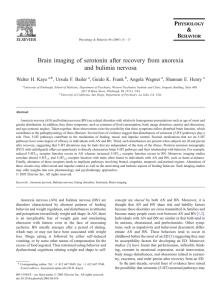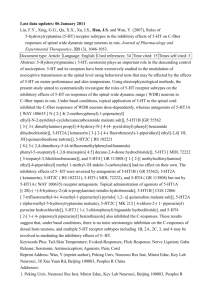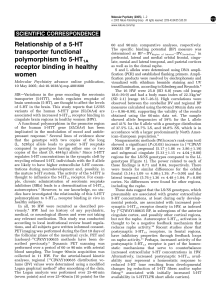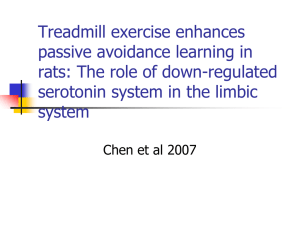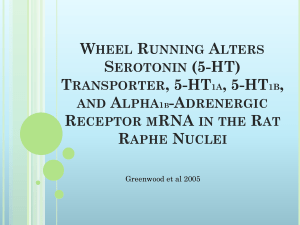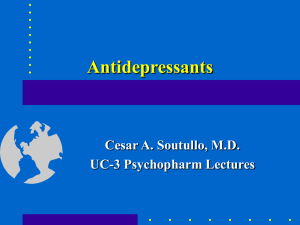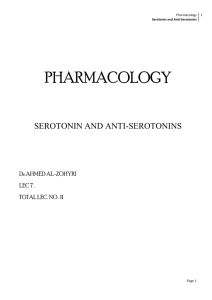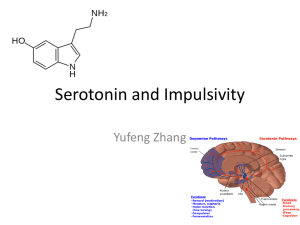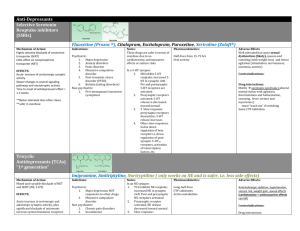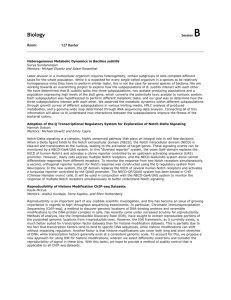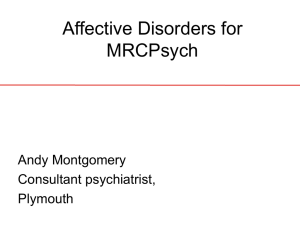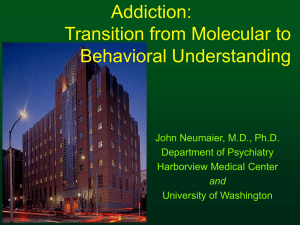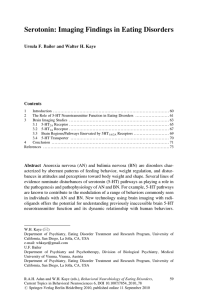Neurobiology of Anorexia Nervosa: Clinical Implications
advertisement
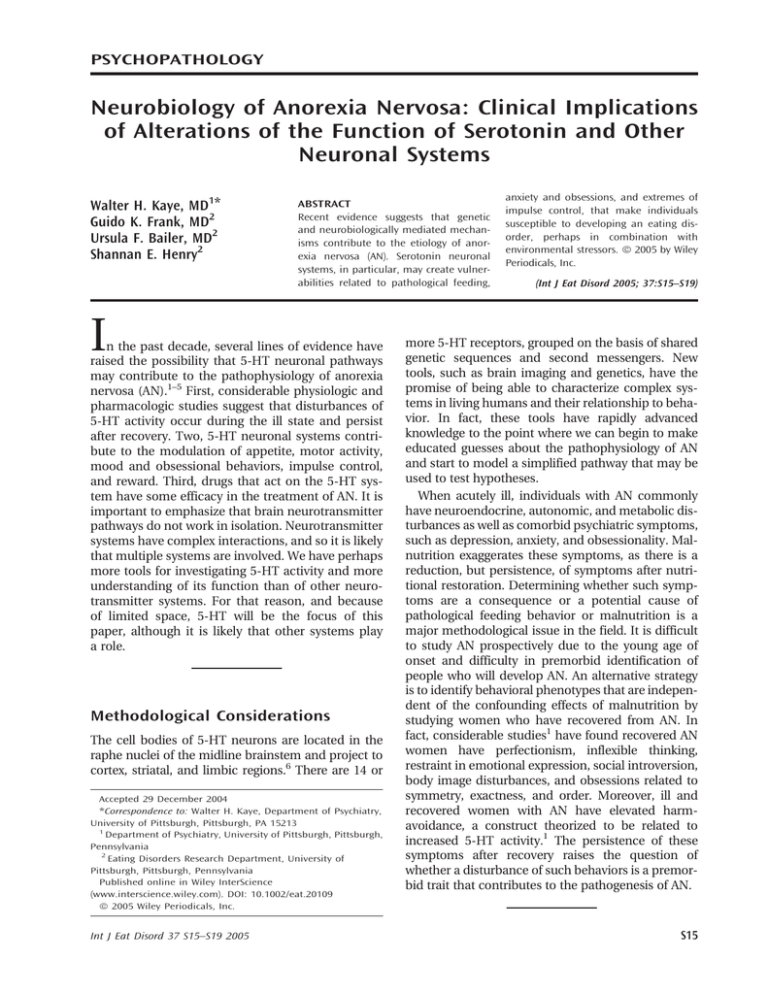
PSYCHOPATHOLOGY Neurobiology of Anorexia Nervosa: Clinical Implications of Alterations of the Function of Serotonin and Other Neuronal Systems Walter H. Kaye, MD1* Guido K. Frank, MD2 Ursula F. Bailer, MD2 Shannan E. Henry2 ABSTRACT Recent evidence suggests that genetic and neurobiologically mediated mechanisms contribute to the etiology of anorexia nervosa (AN). Serotonin neuronal systems, in particular, may create vulnerabilities related to pathological feeding, I n the past decade, several lines of evidence have raised the possibility that 5-HT neuronal pathways may contribute to the pathophysiology of anorexia nervosa (AN).1–5 First, considerable physiologic and pharmacologic studies suggest that disturbances of 5-HT activity occur during the ill state and persist after recovery. Two, 5-HT neuronal systems contribute to the modulation of appetite, motor activity, mood and obsessional behaviors, impulse control, and reward. Third, drugs that act on the 5-HT system have some efficacy in the treatment of AN. It is important to emphasize that brain neurotransmitter pathways do not work in isolation. Neurotransmitter systems have complex interactions, and so it is likely that multiple systems are involved. We have perhaps more tools for investigating 5-HT activity and more understanding of its function than of other neurotransmitter systems. For that reason, and because of limited space, 5-HT will be the focus of this paper, although it is likely that other systems play a role. Methodological Considerations The cell bodies of 5-HT neurons are located in the raphe nuclei of the midline brainstem and project to cortex, striatal, and limbic regions.6 There are 14 or Accepted 29 December 2004 *Correspondence to: Walter H. Kaye, Department of Psychiatry, University of Pittsburgh, Pittsburgh, PA 15213 1 Department of Psychiatry, University of Pittsburgh, Pittsburgh, Pennsylvania 2 Eating Disorders Research Department, University of Pittsburgh, Pittsburgh, Pennsylvania Published online in Wiley InterScience (www.interscience.wiley.com). DOI: 10.1002/eat.20109 ª 2005 Wiley Periodicals, Inc. Int J Eat Disord 37 S15–S19 2005 anxiety and obsessions, and extremes of impulse control, that make individuals susceptible to developing an eating disorder, perhaps in combination with environmental stressors. ª 2005 by Wiley Periodicals, Inc. (Int J Eat Disord 2005; 37:S15–S19) more 5-HT receptors, grouped on the basis of shared genetic sequences and second messengers. New tools, such as brain imaging and genetics, have the promise of being able to characterize complex systems in living humans and their relationship to behavior. In fact, these tools have rapidly advanced knowledge to the point where we can begin to make educated guesses about the pathophysiology of AN and start to model a simplified pathway that may be used to test hypotheses. When acutely ill, individuals with AN commonly have neuroendocrine, autonomic, and metabolic disturbances as well as comorbid psychiatric symptoms, such as depression, anxiety, and obsessionality. Malnutrition exaggerates these symptoms, as there is a reduction, but persistence, of symptoms after nutritional restoration. Determining whether such symptoms are a consequence or a potential cause of pathological feeding behavior or malnutrition is a major methodological issue in the field. It is difficult to study AN prospectively due to the young age of onset and difficulty in premorbid identification of people who will develop AN. An alternative strategy is to identify behavioral phenotypes that are independent of the confounding effects of malnutrition by studying women who have recovered from AN. In fact, considerable studies1 have found recovered AN women have perfectionism, inflexible thinking, restraint in emotional expression, social introversion, body image disturbances, and obsessions related to symmetry, exactness, and order. Moreover, ill and recovered women with AN have elevated harmavoidance, a construct theorized to be related to increased 5-HT activity.1 The persistence of these symptoms after recovery raises the question of whether a disturbance of such behaviors is a premorbid trait that contributes to the pathogenesis of AN. S15 KAYE ET AL. Serotonin Abnormalities in Individuals With AN In terms of serotonin function1–5 individuals who are ill with AN have a significant reduction of cerebrospinal fluid concentrations of 5-HT metabolites compared to control women. In comparison, after recovery, AN participants have higher than normal concentrations of these 5-HT metabolites, which are also about 50% greater than concentrations found in the ill AN state. Acutely ill AN patients have abnormal hormonal response to 5-HT specific challenges in most studies. After various degrees of recovery, hormonal responses tend to normalize in AN but some abnormal hormonal responses may persist. Studies that have used behavior response to 5-HT challenges have found that depletion of tryptophan, the precursor of 5-HT, reduces dysphoric mood in both ill and recovered AN participants. There is some evidence that people with AN may have altered frequency of gene polymorphisms for serotonin receptors.1 A small literature on 5-HT specific reuptake inhibitors (SSRI) and atypical antipsychotic treatment of AN lends further support to the possibility that 5-HT disturbances occur in AN since both of these drugs have effects on the 5-HT system.1 More recently,1 brain imaging has been used to characterize 5-HT1A and 5-HT2A receptors in ill and recovered AN participants, compared to age-matched control women. Our studies7,8 have investigated pure restrictor-type AN (RAN) and bulimic-type AN (BAN). In general, these AN subtypes appear more similar than different after recovery. Measures of anxiety, harm avoidance, obsessions and compulsions, or core eating disorder symptoms were more elevated in the ill state and, while less so after recovery, remained elevated in comparison to control women. In summary, these data are consistent with previous studies that suggest that while recovery occurs in terms of nutritional status, weight, and menses, many recovered participants remain symptomatic. We hypothesize that AN core symptoms, such as anxiety and obsessional perfectionism, are life-long traits that occur premorbidly and persist after recovery, and that subtypes of AN share similar vulnerabilities. Our group7 reported that recovered RAN participants had reduced 5-HT2A receptor activity in the subgenual and pregenual cingulate cortex, and mesial temporal and parietal cortical areas. More recently, our group reported8 that recovered BAN women had reduced 5-HT2A receptor activity relative to controls in subgenual cingulate, mesial temporal, lateral temporal, parietal, and occipital cortical regions. Similarly, Audenaert et al.9 found S16 that ill AN had reduced 5-HT2A activity in the left frontal, bilateral parietal, and occipital cortex. Preliminary data from our group show that recovered RAN individuals may have normal 5-HT1A receptor activity. However, recovered BAN individuals had increased 5-HT1A postsynaptic activity in the subgenual cingulate and mesial temporal regions, and frontal and other cortical regions, as well as increased presynaptic 5-HT1A autoreceptor activity in the dorsal raphe nucleus. Increased 5-HT1A postsynaptic activity has been reported in ill bulimia nervosa participants.10 In terms of 5-HT2A receptor activity, both recovered AN subgroups show persistent alterations in subgenual cingulate and mesial temporal regions. Other types of brain imaging studies1 have found frontal, cingulate, and temporal changes in ill and recovered AN participants. However, samples have been too small to address subtype, and the resolution of many of the imaging studies has not allowed regional specificity. The subcaudal cingulate regions play a role in emotion (‘‘affect component’’) and have extensive connections with the amygdala, periaqueductal grey, frontal lobes, ventral striatum, etc. They are involved in conditioned emotional learning, vocalizations associated with expressing internal states and assigning emotional valence to internal and external stimuli.11 Mesial temporal regions include the amygdala and related regions that play a pivotal role in anxiety and fear12 as well in the modulation and integration of cognition and mood. The amygdala may enable the individual to initiate adaptive behaviors to threat based upon the nature of the threat and prior experience. Together these findings raise the possibility that mesial temporal (amygdala)–cingulate 5-HT2A receptor alterations may be a trait shared by AN subgroups related to anticipatory anxiety and integration of cognition and mood. In comparison, only recovered BAN individuals had a significant increase of 5-HT1A receptor activity in subgenual cingulate and mesial temporal regions. This finding raises the possibility that differences in the 5-HT1A receptor contribute to differences between subtypes of AN participants. 5-HT System and Core AN Symptoms It is possible to begin to generate hypotheses about how altered brain function may contribute to core AN symptoms. There is a good ‘‘fit’’ between alterations of 5-HT function and some behaviors in AN. However, other neuronal systems are likely to be involved, and should be included in hypotheses than can be tested by future studies. Int J Eat Disord 37 S15–S19 2005 NEUROBIOLOGY OF ANOREXIA NERVOSA Appetitive Behaviors People with AN have stereotypic patterns of food choices and altered eating behaviors. People with AN rarely stop eating; rather, they severely restrict their caloric intake. They tend to be vegetarians and often state that they dislike and avoid red meat. Moreover, individuals with AN tend to have monotonous choices in food intake and often have unusual combinations of food and flavors and describe ritualized eating behaviors. Despite such observations, relatively little is known about the regulation of appetite in these disorders. Appetite behavior is a complex system involving gastrointestinal function, hormonal, and peripheral and central nervous system pathways. In the brain, a cascade of monoamines and neuropeptides regulates aspects of feeding such as macronutrient selection, rate of eating, satiety, etc. Stereotypic feeding patterns in AN may be a consequence of specific neurochemical alterations. For example, a case can be made that 5-HT overactivity may contribute to exaggerated satiety in AN. Theoretically, food restriction could be caused by increased intrasynaptic 5-HT or activation of 5-HT receptors.13 However, multiple 5-HT receptors influence feeding such as 5-HT1A autoreceptors or postsynaptic 1B/D or 2C receptors. Furthermore, pathologic eating behavior could be related to altered modulation of food-related reward mechanisms. Tastes, smells, foods, and flavors all consistently activate overlapping regions of the orbital frontal cortex, anterior cingulate cortex, antermedial temporal (including amygdala), and insula,14,15 which are regions implicated in AN and BN. These brain regions may modulate the reward value of a sensory stimulus such as the taste of food. Normally, food tastes pleasant when one is hungry. However, after one has eaten a food to satiety, there is a reduction in the pleasantness of its taste. Thus neurons in the orbital frontal cortex decrease their response to a food eaten to satiety but remain responsive to other foods, contributing to a mechanism for sensory-specific satiety. We hypothesize that women with AN and BN have a disturbance of these hedonic pathways. That is, for AN, there is little hedonic response to food, or rapid development of satiety. In contrast, BN may have exaggerated hedonic response to food, or little development of satiety, so that overeating follows. Anxiety and Obsessive Behaviors Recent studies have shown that most individuals with AN exhibit childhood perfectionism, obsessive-compulsive personality patterns, and Int J Eat Disord 37 S15–S19 2005 anxiety (particularly OCD and social phobia), and these symptoms predate the onset of AN.16,17 It is well known that 5-HT neuronal pathways play a role in the expression of anxiety and fear, obsessional behaviors, and depression.12 Experts have consistently postulated that increased 5-HT activity is inhibitory of behavior18 and may be related to harm avoidance (overconcern with the negative consequences of potentially aversive stimuli). We have found positive relationships between 5-HT2A receptor activity and harm avoidance in recovered BAN in subgenual and mesial temporal regions.8 Theoretically, starvation-induced reductions of extracellular 5-HT would serve to reduce stimulation of the 5-HT2A receptor, and thus reduce anxious states. Body Image Distortion, Perception, and Denial A most puzzling symptom of AN is the severe and intense body image distortion in which emaciated individuals perceive themselves as fat. Theoretically, body image distortion might be related to the syndrome of neglect19 that may be coded in parietal, frontal, and cingulate regions that assign motivational relevance to sensory events. It is well known that lesions in the right parietal cortex may not only result in denial of illness or anosognosia, somatoparaphrenia, the numerous misidentification syndromes, but may also produce experiences of disorientation of body parts and body image distortion. Bailer et al.8 reported negative relationships between 5-HT2A receptor activity and the Eating Disorder Inventory Drive for Thinness scale in the left parietal cortex and other regions. It is intriguing to raise the possibility that left hemisphere disturbances of this pathway may contribute to body image distortion. Physical Activity, Reward, and Substance Use Ill AN have stereotyped hyperactive motor behavior. In addition, they have anhedonic and restrictive personalities, reduced novelty seeking, and a lower incidence of alcohol and drug use. We have found that only recovered restricting-type AN individuals had a significant reduction in CSF levels of homovanillic acid, the major metabolite of dopamine (DA) compared to other subtypes.20 DA neuronal function has been associated with motor activity, reward and novelty seeking. DA and 5-HT systems have intimate relationships. The opposition between 5-HT2A and 5-HT1A receptors modulates dopaminergic neurotransmission.21 DA terminals synapse on the dendritic spines and shafts of pyramidal cells as well as on GABAergic inhibitory interneurons. Moreover, 5-HT2A receptors are located in S17 KAYE ET AL. the substantia nigra and ventral tegmentum from which the nigrostriatal and mesocorticolimbic DA neurons arise, respectively. It is possible that the balance between DA and 5-HT components may be somewhat different in recovered RAN compared to recovered BAN, and thus contributes to specific symptoms in ED subtypes. motivation, and concentration. This in turn might result in disturbances of the ability to solve complex problems like learning new information, planning ahead, activating remote memories, regulating actions according to the environmental stimuli, and shifting behavioral sets appropriately. Such relationships can now be tested by combining cognitive testing strategies with brain imaging. Age and Gender AN is a gender-specific disorder that typically begins within a narrow pubertal/adolescent age range. Considerable data in humans support strong negative relationships between age and 5-HT2A receptors.22 It is less clear whether there are agerelated changes in the 5-HT1A receptor. Our studies have tended to find relationships between age and 5-HT2A receptor activity in recovered AN individuals. In addition, ovarian steroids have widespread effects throughout the brain on 5-HT and other pathways that modulate affect and cognition.23 Interestingly, estrogens may locally regulate events at the sites of synaptic contact in the excitatory pyramidal neurons where the synapses form. We speculate that individuals with AN have an underlying dysregulation of 5-HT functional activity that contributes to anxiety and obsessional symptoms in childhood. Changes in 5-HT function related to age and/or pubertal female gonadal steroids may destabilize 5-HT homeostatic function, and thus contribute to triggering the onset of an ED. Cognition in AN and BN As discussed by Tchanturia (this volume), individuals with AN have attentional impairments and difficulty in executive functioning, attention, working memory, response inhibition, and mental flexibility. AN show a rigid pattern of responding and an inability to change a pattern of response once a behavior has been initiated. These characteristic styles raise the question of whether there is some physiologic disturbance of executive brain mechanisms that detect errors or that plan and verify actions. Perhaps a disturbance of cortical or subgenual cingulate–mesial temporal pathways results in an obsessive focus on certain events and excludes the comprehension and incorporation of other stimuli. While speculative, an altered balance between co-localized postsynaptic 5-HT1A and 5-HT2A receptors may serve to alter the functional activity of cortical regions through effects on pyramidal neurons.24 Thus, increased 5-HT1A and/or reduced 5-HT2A receptor activity in cortical association regions, such as the frontal lobes, could hyperpolarize layer V pyramidal cells which, in turn, might produce effects on working memory, attention, S18 Pharmacological Implications Selective Serotonin Re-uptake Inhibitors (SSRIs). If individuals with AN have a 5-HT disturbance, why are SSRIs ineffective in the ill state?25,26 It is possible that malnutrition-related changes in 5-HT neuronal function may negate the actions of SSRIs in ill AN individuals. One mechanism thought to contribute to the action of SSRIs is desensitization of the somatic dendritic 5-HT1A autoreceptor on the raphe nucleus.27 In addition, SSRIs are thought to have therapeutic effects related to postsynaptic 5-HT1A and 5-HT2A receptors. Our preliminary data show that many ill AN individuals have increased somatic dendritic and postsynaptic 5-HT1A autoreceptor activity. In addition, the major metabolite of 5-HT in the brain is significantly reduced in ill AN individuals, suggesting they have reduced extracellular 5-HT which may be due, in part, to reduced diet-related TRP availability. SSRIs are dependent on neuronal release of 5-HT for their action. Therefore, a clinically meaningful response to an SSRI might not occur. Thus, SSRIs may fail to increase extracellular 5-HT, which, in turn is not able to cause a desensitization/down regulation of 5-HT1A autoreceptors. In contrast, recovered AN individuals have more modest alterations of 5-HT1A and 5-HT2A activity compared to ill AN individuals and evidence of high levels of extracellular 5-HT in the brain. A small double-blind, placebo-controlled study provides evidence that SSRIs may be more effective after weight restoration in preventing relapse and reducing dysphoric mood and core AN symptoms.28 Perhaps SSRIs work more effectively after nutritional restoration, because SSRIs are able to increase extracellular 5-HT, which, in turn, triggers the cascade of effects, such as 5-HT1A autoreceptor desensitization necessary to have a therapeutic response. Atypicals. Open trials raise the possibility that atypi- cal ‘‘antipsychotics’’ may be useful for reducing anxiety or increasing weight in ill AN. Atypicals are thought to have effects on 5-HT2A and 5-HT1A receptors, DA D2 receptors, as well as other systems. It is interesting to note that individuals with AN have a greater magnitude of disturbances of 5-HT1A and 5-HT2A receptors, as well as of CSF dopamine Int J Eat Disord 37 S15–S19 2005 NEUROBIOLOGY OF ANOREXIA NERVOSA metabolites, than is found in schizophrenia. It may be that disturbances of mood and cognition share brain pathways that modulate those functions, but the loci of the disturbances are very different in different disorders. Conclusions A better understanding of the pathophysiology of AN may lead to a more rational choice of medications, new drug targets, and more specific psychotherapies. In addition, it is now possible to investigate the potential relationship of 5-HT functional activity and stereotypic core symptoms such as feeding, temperament and personality, body image distortion, cognition, physical exercise, as well as age of onset and gender. In fact, it may be a reasonable time to consider new research diagnostic criteria for AN that take into account these stereotypic core symptoms. Finally, we need to ally with basic science colleagues who can model 5-HT function and these domains in animals. References 1. Kaye W, Strober M, Jimerson D. The neurobiology of eating disorders. In: Charney DS, Nestler EJ, editors. The neurobiology of mental illness. New York: Oxford Press; 2004. p 1112. 2. Brewerton TD, Brandt HA, Lessem MD, et al. Serotonin in eating disorders. In: Coccaro EF, Murphy DL, editors. Serotonin in major psychiatric disorders. Progress in psychiatry. Washington, DC: American Psychiatric Press, Inc; 1990. p 155. 3. Jimerson DC, Wolfe BE, Metzger ED, et al. Decreased serotonin function in bulimia nervosa. Arch Gen Psychiatry 1997; 54:529. 4. Walsh BT, Devlin MJ. Eating disorders: progress and problems. Science 1998;280:1387. 5. Steiger H, Young SN, Kin NM, et al. Implications of impulsive and affective symptoms for serotonin function in bulimia nervosa. Psychol Med 2001;31:85. 6. Cooper JR, Bloom FE, Roth RH. The biochemical basis of neuropharmacology. 7th edn. New York: Oxford University Press; 1996. 7. Frank GK, Kaye WH, Meltzer CC, et al. Reduced 5-HT2A receptor binding after recovery from anorexia nervosa. Biol Psychiatry 2002;52:896. 8. Bailer UF, Price JC, Meltzer CC, et al. Altered 5-HT2A receptor binding after recovery from bulimia-type anorexia nervosa: relationships to harm avoidance and drive for thinness. Neuropschopharmacology 2004;29:1143. Int J Eat Disord 37 S15–S19 2005 9. Audenaert K, Van Laere K, Dumont F, et al. Decreased 5-HT2a receptor binding in patients with anorexia nervosa. J Nucl Med 2003;44:163. 10. Tiihonen J, Keski-Rahkonen A, Lopponen M, et al. Brain serotonin 1A receptor binding in bulimia nervosa. Biol Psychiatry 2004;55:871. 11. Freedman LJ, Insel TR, Smith Y. Subcortical projections of area 25 (subgenual cortex) of the macaque monkey. J Comp Neurol 2000;421:172. 12. Charney DS, Deutch A. A functional neuroanatomy of anxiety and fear: implications for the pathophysiology and treatment of anxiety disorders. Crit Rev Neurobiol 1996;10:419. 13. Leibowitz SF. The role of serotonin in eating disorders. Drugs 1990;39[Suppl 3]:33. 14. Rolls E. The rules of formation of the olfactory representations found in the orbitalfrontal cortex olfactory areas in primates. Chem Senses 2001;26:595. 15. O’Doherty JP, Deichmann R, Critchley HD, et al. Neural responses during anticipation of a primary taste reward. Neuron 2002;33:815. 16. Kaye WH, Bulik CM, Thornton L, et al. Comorbidity of anxiety disorders with anorexia and bulimia nervosa. Am J Psychiatry 2004;161:2215. 17. Godart NT, Flament MF, Perdereau F, et al. Comorbidity between eating disorders and anxiety disorders: a review. Int J Eat Disord 2002;32:253. 18. Cloninger CR, Svrakic DM, Przybeck TR. A psychobiological model of temperament and character. Arch Gen Psychiatry 1993;50:975. 19. Mesulam MM. A cortical network for directed attention and unilateral neglect. Ann Neurol 1981;10:309. 20. Kaye WH, Frank GK, McConaha C. Altered dopamine activity after recovery from restricting-type anorexia nervosa. Neuropsychopharmacology 1999;21:503. 21. Meltzer HY, Li Z, Kaneda Y, et al. Serotonin receptors: their key role in drugs to treat schizophrenia. Prog Neuropsychopharmacol Biol Pschiatry 2003;27:1159. 22. Adams K, Pinborg LH, Svarer C, et al. A database of [18F]altanserin binding to 5-HT2A receptors in normal volunteers: normative data and relationship to physiological and demographic variables. NeuroImage 2004;21:1105. 23. McEwen B. Estrogen actions throughout the brain. Recent Prog Horm Res 2002;57:357. 24. Martin-Ruiz R, Puig MV, Celada P, et al. Control of serotonergic function in medial prefrontal cortex by serotonin-2A receptors through a glutamate-dependent mechanism. J Neurosci 2001;21:9856. 25. Ferguson CP, La Via MC, Crossan PJ, et al. Are serotonin selective reuptake inhibitors effective in underweight anorexia nervosa? Int J Eat Disord 1999;25:11. 26. Attia E, Haiman C, Walsh BT, et al. Does fluoxetine augment the inpatient treatment of anorexia nervosa? Am J Psychiatry 1998;155:548. 27. Blier P, de Montigny C. Possible serotonergic mechanisms underlying the antidepressant and anti-obsessive-compulsive disorder responses. Biol Psychiatry 1998;44:313. 28. Kaye WH, Nagata T, Weltzin TE, et al. Double-blind placebocontrolled administration of fluoxetine in restricting- and restricting-purging-type anorexia nervosa. Biol Psychiatry 2001;49:644. S19
